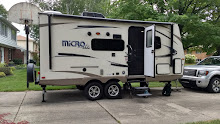Feb. 12-17: We left on Monday
to drive about two hours north to the Phoenix area. Along the way we drove
right by the Casa Grande National Monument and so we stopped to see it. The
ruins of a four story, eleven-room, eleven-family building rise
out of the desert floor, protected by a giant, steel “umbrella”. While its
original use is still debated, it is the only four-story Native American ruin
structure found in the United States and was built about 700 years ago. There
are two small openings in the east and center rooms that are placed so the
sun’s rays come through on the spring and fall equinoxes. We watched a film, toured their museum on our
own, and then had a very good ranger led guided hike of the ruins before
getting back on the road. Archaeologists originally called the people the "Hohokum", which means people who have disappeared. The Native Americans now living in the area consider the term to be an insult; the people are their ancestors and they remain throughout the Southwest.
Our reservation was for the
Lost Dutchman Mine State Park, which is extremely popular and just east of
Mesa. It’s a convenient place to be and we have stayed there one other time so
we’re pretty familiar with it. Our first campsite was in a new loop of
non-electric sites and there was nothing behind us but the Superstition
Mountains. It was a stunning site and we were sorry we could only have it until
Friday.
 |
| Compound A is one of 8 Compounds in the area, and the only one that has been excavated completely, and then partially reburied to help preserve the structures that remain. |
 |
| How it looked in the 1800s when Casa Grande was set aside to protect. |
 |
| Looking inside where visitors are no longer allowed to go it's easy to see some of the replastering that was done years ago to preserve Casa Grande. |
 |
| The rebars are being left in place but no further reinforcements will be done. |
 |
| This shows the south west quadrant, where the level area hides remains just below the surface. The bottom corner has walls for another, smaller building. |

















































